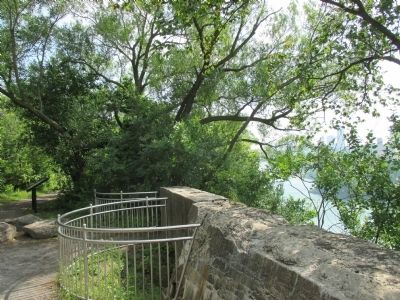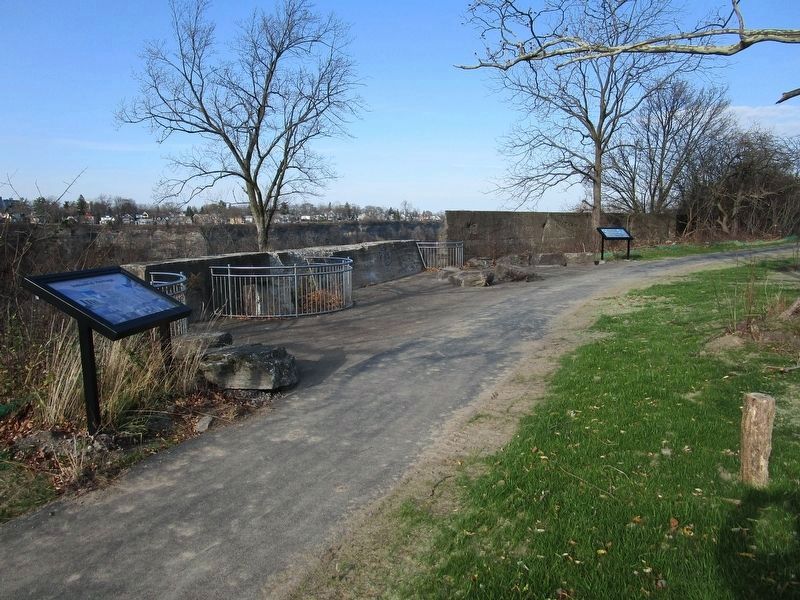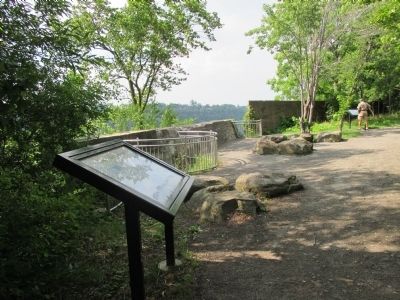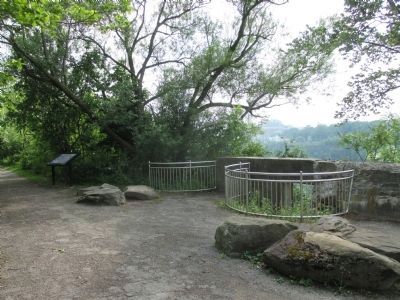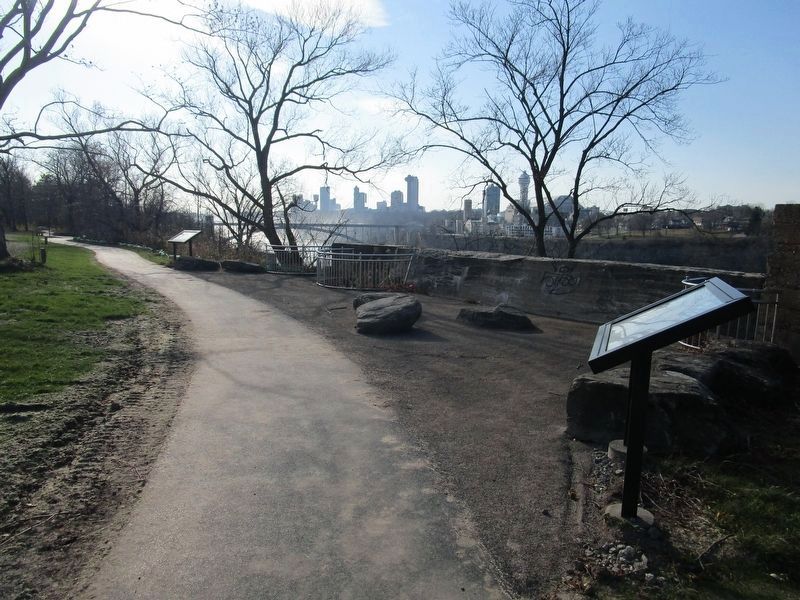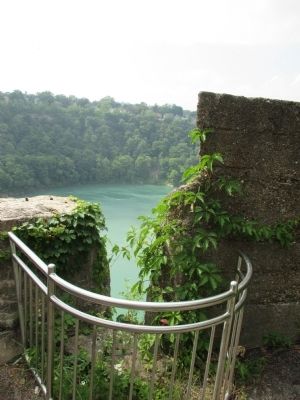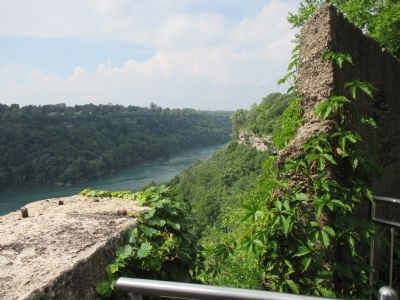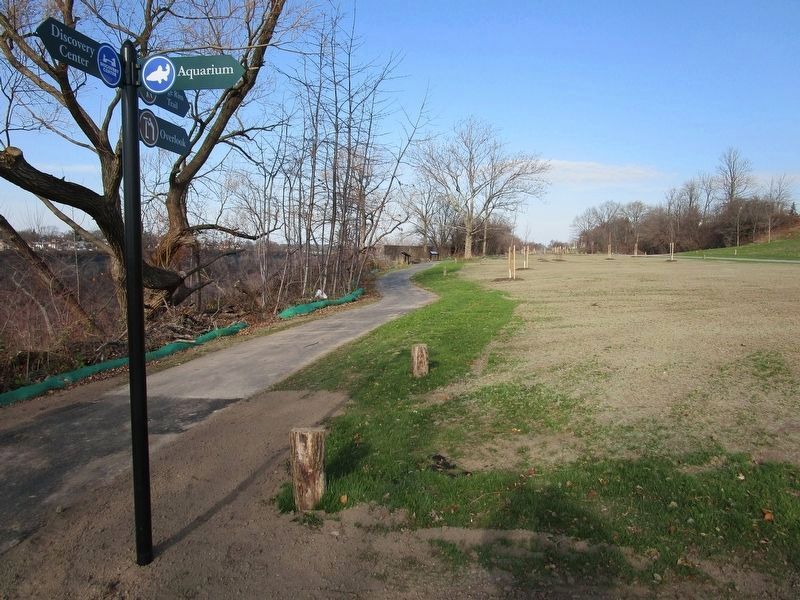Niagara Falls in Niagara County, New York — The American Northeast (Mid-Atlantic)
Niagara Gorge Industrial Heritage
This old wall and staircase was once part of a giant aluminum plant located here in the late 19th and early 20th century. The Pittsburgh Reduction Company built three aluminum plants in the city of Niagara Falls and later named them the Aluminum Company of America (ALCOA).
The first aluminum plant was completed in 1895 a few miles from here on Buffalo Avenue. The other two, completed in 1896 and 1897 respectively, were located on the rim of the Niagara Gorge.
Bauxite Mining + Alumina Refining + Smelting - Aluminum Metal.
The aluminum plants in Niagara Falls based their smelting upon a revolutionary electrolytic process discovered by Charles M. Hall for extracting pure aluminum from common clay. Aluminum smelting traditionally required huge amounts of energy. Hall's process used less electricity and reduced waste by allowing further processing of the aluminum ore. Although today's smelting is more advanced, it is still based on the method Hall invented in his kitchen over 100 years ago.
Did you know? By 1907 ALCOA had contracted with local power companies for 75,000 horsepower, making it the largest aluminum works and user of hydroelectric power in the world.
The Final Product. The aluminum produced in Niagara Falls was refined into masses of metal cast in convenient form for shaping, melting, or refining. These metal "ingots" were sold to other companies at 30 cents per pound. The aluminum was used for airplanes, auto parts, cooking utensils, clock parts, office furniture, and wire.
Topics. This historical marker is listed in these topic lists: Industry & Commerce • Science & Medicine • Waterways & Vessels. A significant historical year for this entry is 1896.
Location. 43° 5.749′ N, 79° 3.665′ W. Marker is in Niagara Falls, New York, in Niagara County. Marker can be reached from Discovery Center Way, half a mile north of Main Street (New York State Route 104), on the right when traveling south. The Niagara Gorge Industrial Heritage Marker is located on the gorge rim trail, north of the Niagara Gorge Discovery Center. Touch for map. Marker is in this post office area: Niagara Falls NY 14303, United States of America. Touch for directions.
Other nearby markers. At least 8 other markers are within walking distance of this marker. Niagara Gorge Important Bird Area (here, next to this marker); Park Place Historic District (approx. 0.2 miles away); The Niagara Falls Power Company (approx. ¼ mile away); The Birth of Hydro Electric Power
(approx. ¼ mile away); In Honor of the Soldiers, Sailors & Marines (approx. ¼ mile away); The Most Combat Decorated World War II Soldier (approx. ¼ mile away); Welcome to Schoellkopf Power Station No.3 (approx. ¼ mile away); Niagara Falls Medal of Honor Memorial (approx. ¼ mile away). Touch for a list and map of all markers in Niagara Falls.
Related marker. Click here for another marker that is related to this marker. Birthplace of the Aluminum Industry.
Also see . . . Charles M. Hall - Wikipedia. (Submitted on July 23, 2014, by Anton Schwarzmueller of Wilson, New York.)
Credits. This page was last revised on November 20, 2020. It was originally submitted on July 22, 2014, by Anton Schwarzmueller of Wilson, New York. This page has been viewed 770 times since then and 69 times this year. Last updated on December 25, 2014, by Anton Schwarzmueller of Wilson, New York. Photos: 1. submitted on July 22, 2014, by Anton Schwarzmueller of Wilson, New York. 2. submitted on July 23, 2014, by Anton Schwarzmueller of Wilson, New York. 3. submitted on November 20, 2020, by Anton Schwarzmueller of Wilson, New York. 4, 5. submitted on July 23, 2014, by Anton Schwarzmueller of Wilson, New York. 6. submitted on November 20, 2020, by Anton Schwarzmueller of Wilson, New York. 7, 8. submitted on July 23, 2014, by Anton Schwarzmueller of Wilson, New York. 9. submitted on November 20, 2020, by Anton Schwarzmueller of Wilson, New York. • Bill Pfingsten was the editor who published this page.

